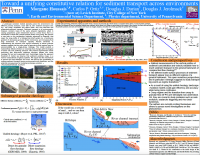CSDMS 2016 annual meeting poster MorganeHoussais
Toward a unifying constitutive relation for sediment transport across environments
Douglas Jerolmack, University of Pennsylvania Philadelphia Pennsylvania, United States. sediment@sas.upenn.edu
Abstract:
Landscape evolution models typically parse the environment into different process domains, each with its own sediment transport law: e.g., soil creep, landslides and debris flows, and river bed-load and suspended-sediment transport. Sediment transport in all environments, however, contains many of the same physical ingredients, albeit in varying proportions: grain entrainment due to a shear force, that is a combination of fluid flow, particle-particle friction and gravity. We present a new take on the perspective originally advanced by Bagnold, that views the long profile of a hillsope-river-shelf system as a continuous gradient of decreasing granular friction dominance and increasing fluid drag dominance on transport capacity. Recent advances in understanding the behavior and regime transitions of dense granular systems suggest that the entire span of granular-to-fluid regimes may be accommodated by a single-phase rheology. This model predicts a material-flow effective friction (or viscosity) that changes with the degree of shear rate and confining pressure. We present experimental results confirming that fluid-driven sediment transport follows this same rheology, for bed and suspended load. Surprisingly, below the apparent threshold of motion we observe that sediment particles creep, in a manner characteristic of glassy systems. We argue that this mechanism is relevant for both hillslopes and rivers. We discuss the possibilities of unifying sediment transport across environments and disciplines, and the potential consequences for modeling landscape evolution.
* Please acknowledge the original contributors when you are using this material. If there are any copyright issues, please let us know and we will respond as soon as possible.

